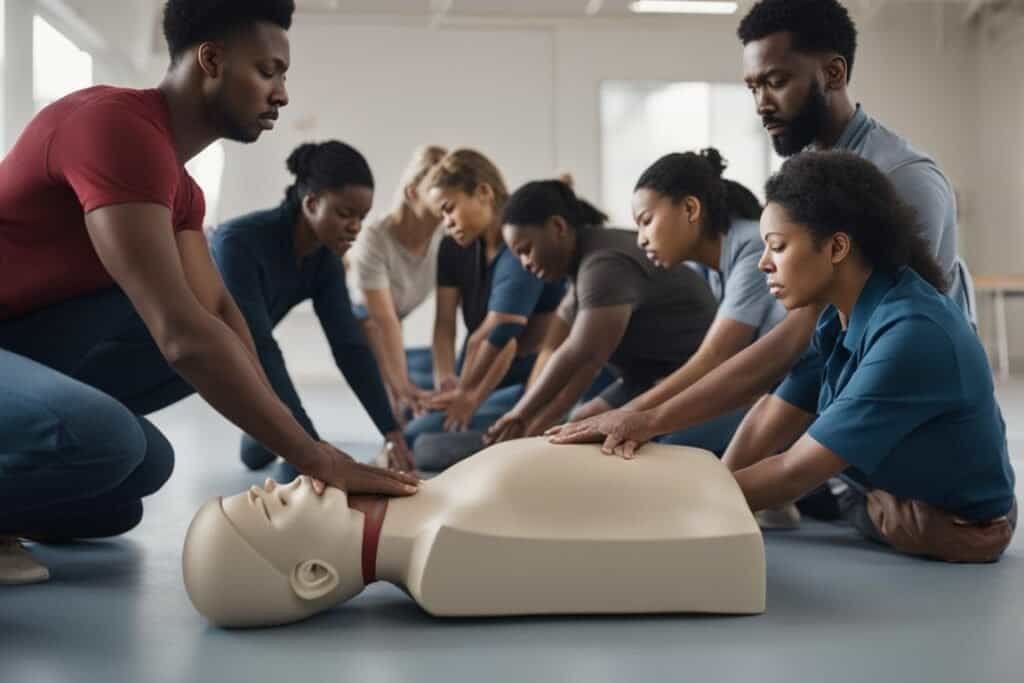Sudden cardiac death in young people is a rare but devastating event. To protect the hearts of the young, it is crucial to take measures to prevent this tragic occurrence. By understanding the risk factors, implementing lifestyle changes, promoting early detection, and raising awareness, we can make significant strides in preventing sudden cardiac death among young people.
Key Takeaways:
- Understanding the risk factors associated with sudden cardiac death, such as underlying heart conditions, is crucial for prevention.
- Making lifestyle changes, such as adopting a healthy diet and engaging in regular physical activity, can promote cardiac health and reduce the risk.
- Regular screenings, like electrocardiograms, can help detect potential abnormalities and prevent sudden cardiac death.
- Education and awareness programs play a vital role in recognizing signs of cardiac distress and ensuring immediate CPR and access to automated external defibrillators (AEDs).
- Genetic testing and counseling can provide valuable insights into inherited conditions associated with sudden cardiac death.
Understanding the Risk Factors for Sudden Cardiac Death
It is crucial to understand the risk factors associated with sudden cardiac death in young people. By recognizing these risk factors, we can take proactive measures to protect the hearts of our youth. The risk of sudden cardiac death is often linked to underlying heart conditions. Some common heart conditions that increase the risk include:
-
Hypertrophic cardiomyopathy: a condition characterized by thickened heart muscle, making it harder for the heart to pump blood effectively.
-
Long QT syndrome: a heart rhythm disorder that can lead to irregular heartbeats and potentially life-threatening cardiac events.
-
Congenital heart defects: structural abnormalities in the heart that are present at birth. These defects can disrupt the normal flow of blood and increase the risk of sudden cardiac death.
To protect our young people from sudden cardiac death, it is crucial to identify and address these risk factors early on. Regular heart evaluations, especially for individuals with a family history of sudden cardiac death or those involved in sports, can help detect these conditions and enable timely intervention.
| Risk Factors | Heart Conditions Associated |
|---|---|
| Hypertrophic cardiomyopathy | Thickened heart muscle |
| Long QT syndrome | Irregular heartbeats |
| Congenital heart defects | Structural abnormalities in the heart |
Lifestyle Changes for Cardiac Health
Making lifestyle changes can play a significant role in preventing sudden cardiac death in young people. By adopting healthy habits, you can improve your cardiac health and reduce the risk of cardiovascular complications. Here are some effective lifestyle changes you can implement:
- Adopt a healthy diet: Focus on consuming a balanced diet that includes fruits, vegetables, whole grains, lean proteins, and healthy fats. Limit your intake of processed foods, sugary snacks, and beverages.
- Engage in regular physical activity: Aim for at least 30 minutes of moderate-intensity exercise, such as brisk walking, cycling, or swimming, most days of the week. Regular exercise helps improve heart function and promotes overall cardiovascular health.
- Maintain a healthy weight: Excess weight puts additional strain on your heart, increasing the risk of cardiac problems. Maintain a healthy body weight by following a nutritious diet and staying physically active.
- Avoid tobacco and excessive alcohol use: Smoking damages your blood vessels and increases the risk of heart disease. Excessive alcohol consumption can also contribute to heart problems. Quit smoking and limit alcohol intake to protect your cardiac health.
- Manage stress: Chronic stress can take a toll on your heart. Practice stress management techniques such as meditation, deep breathing exercises, or engaging in activities you enjoy to reduce stress levels and promote cardiac well-being.
By implementing these lifestyle modifications, you can promote heart health and reduce the risk of sudden cardiac death. Remember, small changes can lead to significant improvements in your cardiac well-being.

Lifestyle Changes for Cardiac Health
| Lifestyle Change | Benefits |
|---|---|
| Adopting a healthy diet | – Provides essential nutrients and reduces the risk of heart disease – Helps maintain a healthy weight |
| Engaging in regular physical activity | – Strengthens the heart muscle – Improves cardiovascular fitness – Helps maintain healthy blood pressure and cholesterol levels |
| Maintaining a healthy weight | – Reduces the strain on the heart – Lowers the risk of heart disease and related complications |
| Avoiding tobacco and excessive alcohol use | – Protects blood vessels and reduces the risk of heart disease – Prevents the development of cardiovascular problems |
| Managing stress | – Reduces the risk of heart disease – Supports overall mental and emotional well-being |
Screening and Early Detection
Early detection of underlying heart conditions is essential in preventing sudden cardiac death. Regular screenings, such as electrocardiograms (ECGs), can help identify potential abnormalities in the heart’s electrical signaling. This screening should be considered for young athletes, individuals with a family history of sudden cardiac death, and those who experience warning signs such as fainting or chest pain.
Screening young individuals, especially those engaging in sports and physical activities, can provide valuable insights into their cardiac health. Identifying potential abnormalities at an early stage allows for timely intervention and appropriate management. By undergoing regular screenings, individuals can ensure their heart health and minimize the risk of sudden cardiac death.
| Risks | Screening Recommendations |
|---|---|
| Youth Athletes |
|
| Family History of Sudden Cardiac Death |
|
| Warning Signs: Fainting, Chest Pain |
|
Education and Awareness
Educating communities and raising awareness about sudden cardiac death and the importance of immediate response can save lives. By providing comprehensive education and ensuring widespread awareness, we can empower individuals to take immediate action when faced with cardiac distress.
Education begins with young people themselves. Teaching them about the signs and symptoms of cardiac distress creates a knowledgeable and proactive generation. Additionally, educating families, coaches, and medical professionals is essential, as they play crucial roles in recognizing the warning signs and initiating the appropriate response.
One of the most important aspects of education is CPR training. Cardiopulmonary resuscitation (CPR) is a life-saving technique that anyone can learn. By providing CPR training to as many individuals as possible, we can create a network of first responders capable of administering immediate care until professional help arrives.
Moreover, it is essential to spread awareness about the availability and use of automated external defibrillators (AEDs). AEDs are portable devices that analyze the heart’s rhythm and deliver an electric shock, if needed, to restore normal heart function. By ensuring AEDs are accessible in public spaces, schools, and sports facilities, we can increase the chances of survival in cases of sudden cardiac arrest.

| Benefits of Education and Awareness Programs |
|---|
| – Improved recognition of cardiac distress symptoms. |
| – Increased likelihood of immediate response. |
| – Greater availability and accessibility of AEDs. |
| – Enhanced knowledge of CPR among the community. |
| – Empowered individuals capable of saving lives. |
By emphasizing education and awareness in the fight against sudden cardiac death, we can create a culture of readiness and preparedness. Together, let’s ensure that every person receives the knowledge and training they need to respond effectively and save lives in the face of cardiac emergencies.
Genetic Testing and Counseling
Genetic testing and counseling are valuable tools in understanding inherited conditions that may increase the risk of sudden cardiac death. By analyzing an individual’s DNA, genetic testing can identify specific gene mutations associated with these conditions. This information can help healthcare professionals develop personalized treatment and prevention strategies tailored to each individual’s genetic profile.
Genetic counseling is an essential component of the testing process. It provides support and guidance to individuals and families affected by inherited conditions. A genetic counselor can explain the implications of the test results, answer questions, and help individuals make informed decisions about their healthcare options.
When it comes to sudden cardiac death, genetic testing can help identify underlying conditions such as hypertrophic cardiomyopathy, arrhythmogenic right ventricular cardiomyopathy, and long QT syndrome, among others. Detecting these conditions early can enable healthcare providers to implement proactive measures, such as regular cardiac monitoring, medication management, lifestyle modifications, and counseling, to reduce the risk of sudden cardiac events.
Understanding your genetic predisposition can empower you to make informed choices for your cardiac health. If you have a family history of sudden cardiac death or are concerned about inherited conditions, speak with your healthcare provider about the potential benefits of genetic testing and counseling.
| Benefits of Genetic Testing and Counseling | How it Can Help |
|---|---|
| Identification of gene mutations | Guide treatment and prevention strategies |
| Early detection of underlying conditions | Implement proactive measures to reduce risk |
| Support and guidance for affected individuals and families | Address concerns and make informed decisions |
Emergency Preparedness
Being prepared for emergencies is crucial in preventing sudden cardiac death. By implementing emergency response plans, ensuring the availability of automated external defibrillators (AEDs) in public spaces and sporting venues, and providing CPR training to individuals, we can significantly improve survival rates in cases of sudden cardiac arrest.
In the event of a cardiac arrest, quick access to an AED can make a life-saving difference. AEDs are portable devices that deliver an electric shock to the heart to restore its normal rhythm. With proper training, anyone can use an AED to assist someone experiencing sudden cardiac arrest.
CPR (Cardiopulmonary Resuscitation) is another vital skill that can help save lives. It involves providing chest compressions and rescue breaths to a person in cardiac arrest, keeping their blood flowing until medical professionals arrive. CPR training equips individuals with the knowledge and confidence to respond effectively in emergency situations.
Additionally, it is essential to have well-defined emergency response plans in place. These plans should outline the necessary steps to be taken in the event of a cardiac emergency, including how to access AEDs, who should administer CPR, and how to contact emergency medical services.
By prioritizing emergency preparedness through AED availability, CPR training, and well-structured response plans, we can create safer environments and increase the chances of saving lives in cases of sudden cardiac arrest.
Conclusion
Preventing sudden cardiac death among young people is crucial. By implementing a comprehensive approach that focuses on understanding the risk factors, making lifestyle changes, promoting early detection, and educating the community, we can take significant steps towards reducing the incidence of this tragic event.
Understanding the risk factors associated with sudden cardiac death, such as underlying heart conditions, is essential. Regular screenings and early detection can help identify potential abnormalities and enable timely intervention to prevent sudden cardiac death.
Additionally, promoting a healthy lifestyle through diet, exercise, and stress management can contribute to cardiac well-being. Education and awareness programs that highlight the signs and symptoms of cardiac distress, as well as the importance of immediate CPR and access to automated external defibrillators (AEDs), can save lives in case of sudden cardiac arrest.
By adopting genetic testing and counseling, individuals and families can gain valuable insights into inherited conditions that may increase the risk of sudden cardiac death. This knowledge can guide treatment and prevention strategies and provide necessary support to those affected.
Together, through these preventive measures and a collaborative effort, we can protect the hearts of our young people and ensure their well-being for a healthier future.

